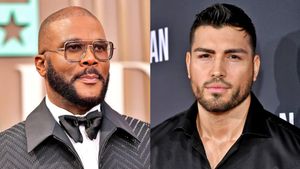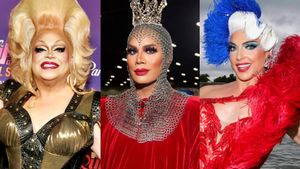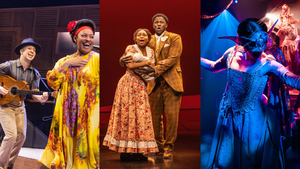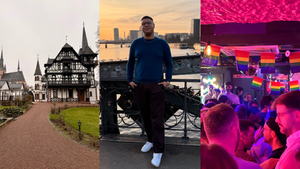Most of the planet had not yet learned that the new first name of the world's greatest athlete was Caitlyn, when The New York Times decided to tell the stories of Daniel, Roxanne, Rebecca, and Jase.
The now-famous image of the transformed former Olympian remained a closely-guarded secret for weeks, while readers of The Times could, with just a click of a mouse, see and hear all about Katherine, Rhys, Micah, and Brynn.
They are just some of the hundreds of transgender people from around the world who have accepted an invitation by the "Paper of Record" to tell their own stories, by submitting an essay or uploading a video.
"Transgender Today" is the first such endeavor of this size in the illustrious history of the world-famous newspaper, nicknamed more than half a century ago "The Old Gray Lady."
Given that "Transgender Today" launched a full month before every media outlet on earth jumped on the Caitlyn Jenner bandwagon to cover "the transgender experience," The Times showed prescience in opening its pages to what has often been called a community, even though it rarely behaves as one.
Jenner's transformation, in fact, has been mentioned in more than 50 Times articles, just since April. "It was definitely not a reaction to Jenner," Andrew Rosenthal (left in the picture below), editorial page editor of The New York Times told The Advocate.

He and out editorial writer Ernesto Londono sat down with The Advocate at the newspaper's modern Manhattan headquarters last month for an in-depth conversation about the who, what, where, when, why, and how this series came about.
In our conversation, Rosenthal and Londono did not conceal even for a moment their goal in creating the "Transgender Today" series: to effect change.
"Often times, when the subject of transgender people comes up, the focus is on the genitals," said Londono. "There is a sexualizing of the concept and that evokes thoughts of kink, of the bizarre. What we want writ large, to keep the emphasis on, is that this is all about identity. What this is about is acceptance."
Londono pitched the concept and has written much of what readers see in the "Transgender Today" series, which thus far is comprised of five parts: "The Challenge," "The C.I.A.," "Visibility," "Military" and "Trans Voices" -- where transgender people have uploaded their own stories in numbers Rosenthal says the paper never envisioned.
"We thought, maybe, maybe we'd get a few dozen submissions, and now we're up to, I don't know, hundreds, from everywhere." Rosenthal says. Among the most poignant, they agree, is the story of 7-year-old Avery Jackson.
Avery's mom, a self-described conservative, Southern Baptist from Alabama, told her daughter's story a little over a year ago, in Kansas City. The video of her speech has been viewed more than half a million times, and no doubt triggered more than a million tears.
"My daughter is a girl in her heart," said Debi Jackson in that now-viral video. "She knows it, God knows it, and that's good enough for me."
Avery's father, Tom, wrote to The Times: "Recently, our daughter has asked us to let her tell her story -- in her own words, because she is proud of who she is and wants to help other kids like her to 'change the world.'" His letter accompanies a video Avery recorded, introducing herself.
"Hi, I'm Avery," she says in the video, wearing a pink top decorated with pink butterflies, her long hair framing her gentle features as she bounces in her chair. "I'm 7 years old. I like to climb trees, be a ninja, pretend I'm animals... and, oh yeah: I'm transgender. When I was born doctors said I was a boy, but I knew in my heart I was a girl."
Rosenthal said in this single, self-narrated video, Avery covered all the issues any trans advocate and educator could hope to address: restroom legislation, school board intransigence, civil rights, and public acceptance of the transgender population as authentic. And she did it with a composure and poise far beyond her years:
"Some people say that I don't go to the right bathroom or go to the right restrooms, but who cares about my body parts? I don't ask what's in your underwear!
"There are still some people who don't understand, or are scared, because I'm a little bit different. But we want to fix that!
"Being transgender is a hard thing, but you can be who you want to be. I'm proud of who I am, because I'm transgender, and I'm a girl. And I'm just a normal girl. Your average, everyday, normal transgender girl."
Avery's message echoed the first words in the editorial series: "Being transgender today is still unreasonably hard, but it is far from hopeless."
"We wanted to create a safe space where transgender people could share their stories," Rosenthal says, acknowledging that the Internet can be a very dark place when the public is invited to comment on articles about trans people.
 Dawn Ennis and Ernesto Londono
Dawn Ennis and Ernesto Londono
Even in that liberal bastion that is The Times, some people, no matter how educated, refuse to accept transgender men as men and trans women as women.
Sunday's op-ed by journalist and former women's studies professor Elinor Burkett, "What Makes a Woman?" is the most recent example of this line of thought. Burkett cited difficulties with unnamed "trans activists" and "leaders," used words such as "undermine" and "undercut" to describe how transgender efforts at inclusion negatively impacted women, and ignored years of research on how the brains of transgender individuals more closely match those of the gender with which they identify. Burkett's point, that the "trans movement... is demanding that women reconceptualize ourselves," conveyed a tone-deafness to reality that outraged transgender readers and allies alike.
"There are ignorant, stupid people in the world," Rosenthal told The Advocate. "We didn't know what to expect when we started this. But the response has been beyond what we imagined. The atmosphere has improved enormously, and it's because the voices are there."
"It takes great courage to speak out about this issue," Londono wrote in a Times blog, "because allowing kids to transition genders remains a controversial and fraught issue even among experts on gender identity. Parents of transgender kids who share their stories often get attacked on social media.
"But greater awareness of this issue stands to help kids who would otherwise grow up feeling tormented by their gender identity."
The bulk of the submissions are from those grown-ups whose lives had been, and sometimes still are, tormented.
"I've had friends who said that they regarded being transgendered [sic] as a blessing," wrote Wynelle Snow, a doctor from Alaska. "I think that I felt it to be more a curse." She tells the story of how she was mistreated at a hospital in Texarkana after disclosing she had undergone gender-confirmation surgery. Her horror story is contrasted with a photograph from a far happier hospital experience, showing her lovingly holding a newborn baby.
Valerie Star of Texas submitted a "before and after" photograph that, at first glance, appears to show two very different people. But the snapshots, taken more than two years apart, are of the same person, before and after her transition, which she describes as "the most difficult, yet most rewarding thing I've ever done."
She is seen bearded and burly in the "before" picture, then blonde and tres femme in her photograph from April of this year. And in both, she has a pipe dangling from her mouth, as if to clarify: this is one and the same person.
"I was tired of living in a shell of myself, and I'm so glad I've made this journey," Star wrote.
Mark Mulligan wrote to The Times about his struggle for acceptance as he pursues a Ph.D. in American History, his experience of "subtle (and not-so-subtle) forms of estrangement and retaliation." As an out queer man assigned female at birth, he says "nothing matches the devastation of seeing someone who used to respect you come to see you as an insect."
And, he says, being a bisexual with a partner who is male has exposed him to homophobia, something he considers ironic:
"In this moment of a so-called 'transgender tipping point,' I hope we can use the spotlight currently pointed at us to illuminate the diversity of our experiences. There isn't one cookie-cutter narrative for being transgender, which will hopefully become more evident as more of us make ourselves known."
These are just a few of the everyday men and women alongside those more well-known for being transgender, such as author, educator, and Times contributor, Jennifer Finney Boylan, in addition to GLAAD's Tiq Milan, Gender Rights Maryland executive director Dana Beyer, National Center for Transgender Equality director of policy Harper Jean Tobin and more.
Rosenthal concedes that as much as he has learned, the series is for him, like most cisgender folks, an education about being transgender today. He revealed he does know his Latin, even if the word "cisgender," meaning not transgender, is new to him: "if it's 'cis' from the Latin for 'on this side of,' then it should be pronounced, 'kiss,'" he stated, confidently.
But unlike many journalists across America, Rosenthal worked alongside someone transgender, beginning in 1997.
Donna Cartwright was a highly respected copy editor for The New York Times, who retired in 2006 after three decades on the job. The National Lesbian Gay Journalists Association, which inducted Cartwright into its LGBT Journalists Hall of Fame last year, said Cartwright is believed to be the first Times staffer to publicly disclose her status as a transgender person. She was interviewed in 1998 by Barbara Walters about her decision to resolve her gender conflict and to transition to live as the woman she knows herself to be.
"It was a really eye-opening experience," said the editor, whose father was A.M. Rosenthal, the Pulitzer Prize-winning foreign correspondent who became the executive editor of The New York Times and led the paper's global news operations for 17 years, and died in 2006.
Thanks to Cartwright, Rosenthal got a baptism by fire in what modern-day managers must understand about the importance of language when it comes to trans employees. "Writing the memo trying to explain this to our staff, 250 words, and I managed to avoid a single pronoun!" he boasted. Rosenthal said he recalled Cartwright as an excellent and effective member of The Times' staff.
He conceded that to his knowledge, there were no openly transgender members currently on staff, but he defended the newspaper's track record on diversity in its opinion section, with a stable of 40 columnists and contributors including Maureen Dowd, Frank Bruni -- The Times' first out gay columnist -- and Boylan, its first openly transgender regular contributor.
Rosenthal and Londono want the "Transgender Today" series to have a lasting effect. "We tried doing something similar to this, but not on this grand a scale, when we did the series on marijuana," said Rosenthal. The Times, a longtime supporter of medical marijuana, published an editorial in July 2014 advocating an end to the legal prohibition of marijuna.
At the time, Rosenthal wrote:
"We believe that this is a big issue for the country -- not because we think everyone should be smoking pot, but because while you were reading this blog post, there's a good chance that, somewhere in the country, a young man -- probably an African-American man -- was arrested on a marijuana violation. Even if he is spared a prison term, that arrest is likely to severely harm, if not ruin, his life."
And Londono, who covered the Pentagon and went to war for the Washington Post, was a key figure in The Times' editorials pushing the Obama administration to renew relations with Cuba, a series which NPR explored with Londono in January.
He spoke with Terry Gross about what he had learned about gay life in Cuba, and about the significant influence his editorials appeared to have on the Obama administration; the president announced the normalization of relations between the two countries in December 2014.
The first in that series was published by The Times online in Spanish, and soon after, Cubans were reading his words under the byline Fidel Castro, quoting his editorial.
Privately, Londono confided to The Advocate that he hopes this series will be as impactful. And there's new evidence to support that hope.

On the evening The Times called on the Pentagon to "Let Transgender Troops Serve Openly," the U.S. Air Force abruptly announced it would do exactly that.
Our conversation was interrupted by a spry, 64-year-old man with a copy of The Times rolled up in his hand.
"Sorry to barge in, but I'm just so, so impressed," said the man. "Wonderful work, incredible."
After a firm shake of his hand, a clasp of Londono's shoulder and a brief hello to me, the gentleman departed.
"Does Arthur Ochs Sulzberger, Jr., publisher of The New York Times, regularly step into your office and tell you that you did a good job?" I asked.
Read the "Trans Voices" section of The New York Times here, or submit your own story by clicking here.



 Dawn Ennis and Ernesto Londono
Dawn Ennis and Ernesto Londono


































































Charlie Kirk DID say stoning gay people was the 'perfect law' — and these other heinous quotes